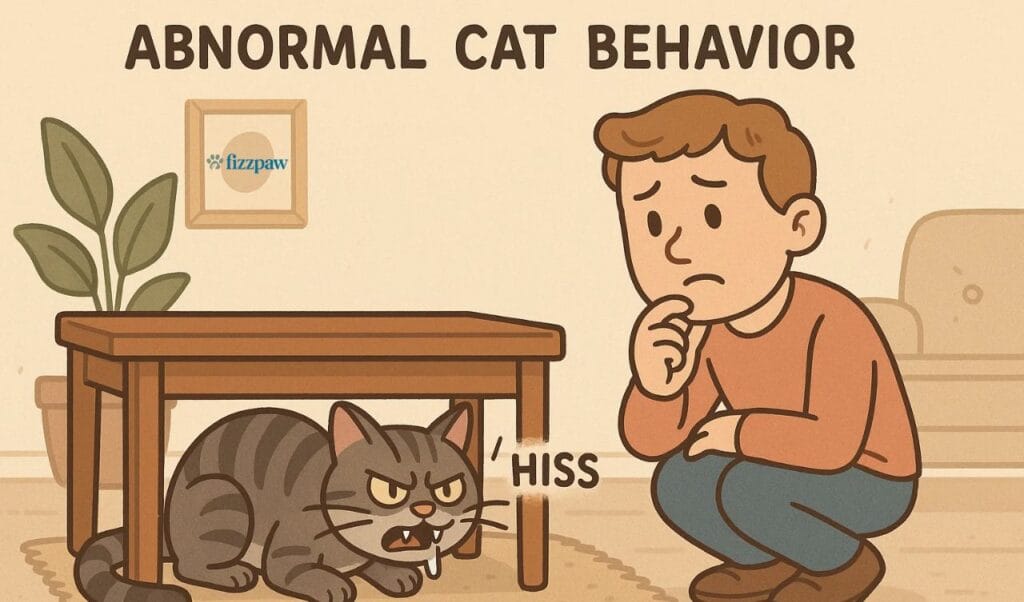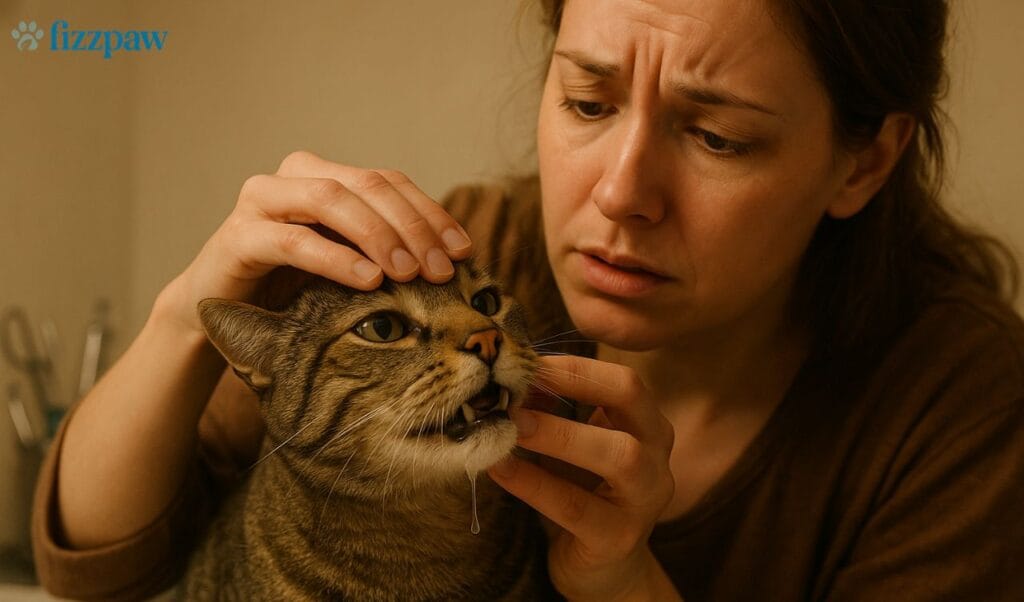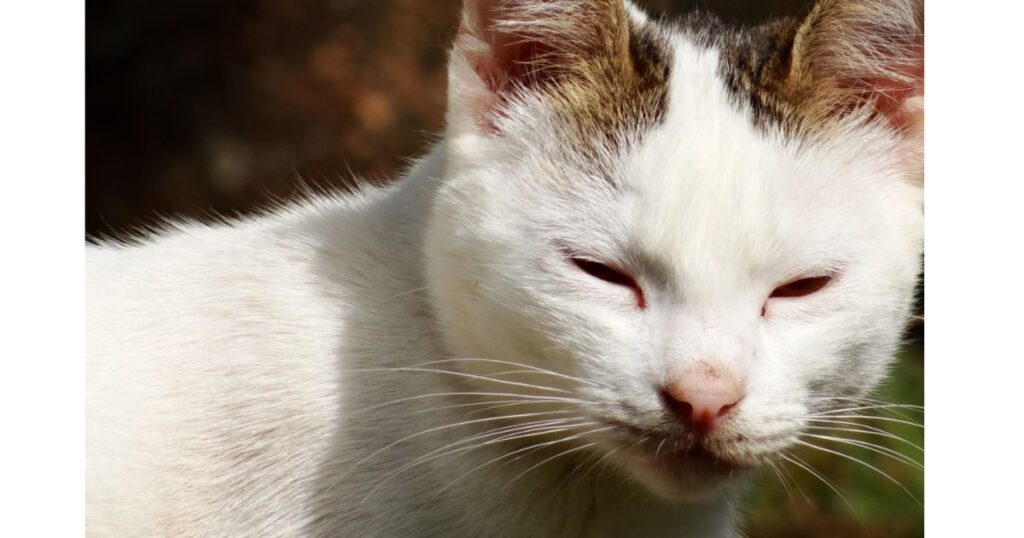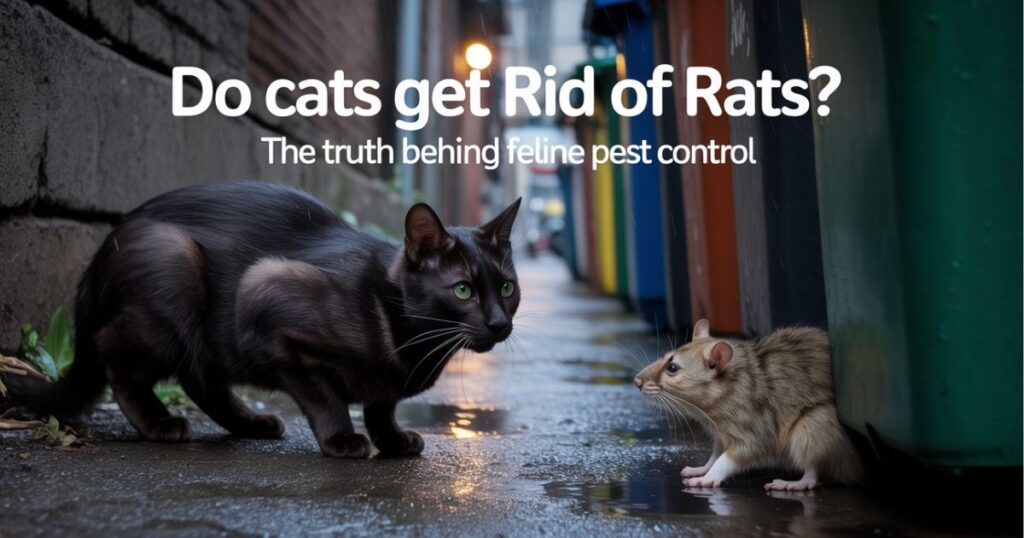It’s natural to be worried if you notice your cat drooling more than usual. Why do my cat drooling? It’s a question many cat parents ask when they suddenly notice a wet patch on their lap or floor. While a small amount of drool may seem harmless, especially when your cat is relaxed or purring, excessive salivation can hint at deeper issues.
From feline ptyalism and cat mouth injury to dental disease in cats, drooling may be your cat’s silent cry for help. Some cases are minor and temporary, but others may demand urgent vet care. Understanding the drooling in cats can help you act swiftly and protect your pet’s health. Let’s explore why this happens, when to worry, and what to do next.
Is Cat Drooling Ever Normal?
Yes, drooling can sometimes be completely normal in cats. It usually happens when your cat is deeply relaxed, like when kneading or purring. Many cats start drooling while purring due to a comforting feeling that reminds them of nursing as kittens. This is common and nothing to worry about. However, normal drooling is:
- Occasional
- Small in amount
- Happens during content or calm moments
Some happy cats drool when being petted or while lying in your lap. So, “Why does my cat drool when I pet him?” The answer is: it’s usually because they’re happy, calm, and associating the moment with kittenhood.
“Is it normal for cats to drool while purring?” Yes, but only in tiny amounts and during peaceful moments.
When Should You Be Concerned About Cat Drooling?
Drooling in cats, while often harmless, can sometimes point to an underlying medical condition. Excessive drooling can happen due to various reasons, including dental disease, nausea, or even poisoning. It’s important to observe your cat’s other behaviors and symptoms to assess the severity of the situation. If your cat is drooling a lot and also showing signs of distress such as lack of appetite, vomiting, or lethargy, it’s time to visit your vet.
Abnormal Cat Behavior

Some behaviors that could accompany abnormal drooling include:
- Pawing at the mouth: Indicates discomfort or a foreign object stuck in the mouth.
- Swallowing problems: Difficulty swallowing could mean a cat mouth injury or other internal issues.
- Vomiting: If your cat is drooling and also vomiting, it might point to nausea or trouble swallowing properly.
- Unusual panting: Heavy or unusual breathing may indicate a respiratory problem or even early signs of heatstroke in cats.
If your cat exhibits any of these behaviors, prompt medical attention is needed.
It’s time to worry when drooling becomes:
- Constant or excessive
- Mixed with blood or foul smell
- Paired with other symptoms like vomiting, hiding, or pawing at the mouth
These signs may point to cat excessive salivation, feline ptyalism, or a serious health issue. Ask yourself, “Should I worry if my cat drools a lot?” If your gut says yes, contact the vet.
Here’s a quick checklist to help you decide:
| Signs to Worry About | Possible Cause |
| Drooling + not eating | Dental issues, poison |
| Pawing at face | Mouth pain, foreign object |
| Vomiting + drooling | Nausea, GI upset |
| Drooling in senior cats | Oral tumors, kidney issues |
| Bad breath + drool | Dental disease in cats |
Medical Causes of Cat Drooling
Several health issues can cause a cat to drool. One of the most common causes of drooling in cats is poor dental health. Painful gums, broken teeth, or infections can make swallowing hard, leading to drooling. Some other medical causes include:
- Cat oral health problems (like stomatitis or ulcers)
- Cat swallowing problems
- Cat nausea symptoms from hairballs or internal disease
- Cat trauma drooling (injuries in the mouth)
Serious illnesses such as heatstroke in cats, rabies signs in cats, or exposure to a cat licking poison (like pesticides) can all cause drooling vs vomiting patterns.
“Can dental problems make cats drool?” Absolutely. Dental pain is a major drooling trigger.
Emotional & Behavioral Triggers for Drooling
Cats aren’t just physical beings. Emotions like fear or happiness can trigger drooling too. Stressful events like vet trips or loud noises can cause some cats to drool. This is known as cat motion sickness.
So, “Can stress cause drooling in cats?” Yes. Just like people might sweat when nervous, cats may salivate.
Behavioral triggers include:
- Anxiety or fear responses
- Excitement during play
- Overstimulation during petting
Stress Drooling
Some common situations where stress can cause drooling include:
- New pets or people in the house
- Moving to a new home or place
- Loud noises or sudden changes in the environment
“Why is my cat drooling and not eating?” Emotional distress or physical pain might be the cause. Monitor and act fast.
Environmental or Accidental Triggers
Sometimes, it’s the surroundings. A cat foreign body in mouth, like string or toy parts, can make your cat drool. Be extra cautious with yarn and threads – a string stuck in cat’s mouth can turn deadly.
Toxic exposure is another big one. Is drooling a sign of poison in cats? Yes, and it’s often one of the first signs. Toxic triggers include:
- Pesticides
- Human meds
- Unsafe plants (not safe plants for cats)
Even bitter cat medications can cause temporary drooling, especially if the taste lingers in their mouth.
Safe Plants for Cats

Here’s a quick guide to some common safe plants for cats to prevent accidental poisoning:
- Spider plant
- Catnip
- Areca palm
- Boston fern
Make sure to keep harmful plants out of reach, as toxic plants for cats can cause serious health issues. Some drooling cases stem from gastrointestinal irritation. If your cat also has loose stools, read our natural diarrhea remedies guide for safe at-home care.
Home Checks: What to Look for in Your Cat’s Mouth and Behavior
Before rushing to the vet, perform a safe and gentle check at home.If your cat is drooling excessively, it’s important to check for any signs of oral injury or infection. Use this home check checklist:
- Look for redness, bleeding, or swelling in the gums
- Check for stuck objects under the tongue
- Smell their breath (bad odor = trouble)
- Watch for abnormal cat behavior like hiding or aggression
If you find any of these signs or if your cat pulls away, it’s time for a vet.
“How to tell if cat drooling is serious?” Look for more than just saliva. Add changes in mood, eating, and energy.
How Vets Diagnose Excessive Drooling
Your vet will first perform a thorough oral exam. They may use sedation if your cat is too stressed. If no clear issue is visible, they might move to blood tests, urine samples, or x-rays.
Veterinary diagnosis may include:
- Testing for kidney or liver disease
- Checking for oral tumors
- Full dental examination
- Reviewing diet and toxin exposure
Cat dental cleaning anesthesia is often needed for a complete view of dental disease.
Treatment Options Based on Cause
Once the problem is found, the vet chooses the best plan:
| Cause | Treatment |
| Dental issues | Cleaning, extractions, and antibiotics |
| Poison exposure | IV fluids, activated charcoal, anti-toxins |
| Foreign body | Removal (sometimes surgery) |
| Anxiety | Calming meds, sprays, behavior therapy |
Mild cases may only need medication or dietary changes. Severe ones might need surgery or hospitalization.
“What to do if cat is drooling excessively?” Don’t wait. Timely vet care can save lives.
Prevention Tips to Avoid Future Drooling Issues
Prevention saves time, money, and pain. To prevent excessive drooling in the future, consider these tips:
- Maintain good dental hygiene: Brush your cat’s teeth regularly and provide dental treats to keep their teeth clean.
- Avoid toxins: Be mindful of harmful chemicals or plants that could poison your cat.
- Reduce stress: Keep your cat’s environment calm and predictable to reduce anxiety-related drooling.
Here’s how to keep your cat drool-free:
- Regular dental check-ups (1-2x per year)
- Brush your cat’s teeth weekly
- Use safe plants for cats at home
- Keep strings, toys, and threads out of reach
- Watch for symptoms of sick cat like changes in appetite
Keep stress low using pheromone sprays, a calm environment, and gentle handling.
“What are emergency signs of cat drooling?” Heavy drooling + vomiting, collapse, or bleeding means call the emergency vet now.
FAQs About Cat Drooling
Why is my cat drooling and pawing at his mouth?
This often means pain, injury, or something stuck in the mouth. See a vet immediately.
Is it normal for a cat to drool?
Mild drooling can be normal in cats when they’re relaxed or purring, but frequent or excessive drooling usually signals an underlying health issue.
Why is my cat dripping clear liquid from mouth?
Clear liquid drooling often indicates nausea, dental disease, or a foreign object stuck in your cat’s mouth and should be evaluated by a vet if it persists.
Do happy cats drool?
Yes, especially when purring or kneading. It’s tied to kitten nursing memories.
What causes cats to drool suddenly?
Common reasons include dental pain, toxins, foreign objects, or anxiety triggers.
Conclusion:
If you’re still wondering, “Why do my cat drooling?”, remember: a small amount of drooling can be normal, but excessive drooling is often a red flag. Stay alert, stay informed, and when in doubt, visit your vet. Your cat depends on you to notice the signs early.




